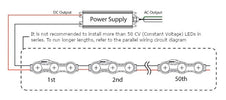
LED Wiring Guide
, by Jasper Kang, 2 min reading time

, by Jasper Kang, 2 min reading time
LED Wiring Guide
Whether you are using LED Strips or modules, the LEDs will commonly operate on 5v, 12v or 24v. The common electrical outlet in North America outputs 120v.
Do not ever attempt to plug in these types of LEDs directly into a wall outlet, as the high voltage will instantly destroy all of your LEDs.
LED Drivers, also known as LED transformers or power supplies are required to transform high voltage to low voltage power. All Interone LED Modules operate on 12v. Our iop series transforms standard 120v to 12v. If you have a higher operating input voltage (90-277v), use our fop series to safely transform 240v to 12v.
All Interone LED modules operate on CV (Constant Voltage) mode. This means that attaching multiple strings of LEDs together in series is not recommended. Interone Modules have a maximum recommended run of 1 string (50 modules) in series. Use parallel wiring to install lines of more than 50 modules.
All Interone and Union LED Drivers also operate on CV mode so you do not have to worry about compatibility. If you have LEDs or LED Drivers that operate in CC (Constant Current) mode, they are not compatible with CV. Constant Current LEDs and LED Drivers are much more expensive than CV, but have easier installation. If you are working with CC, then the LED lights can all be installed in series with no regard for max runs or parallel wiring.
There are many more PROS with CV LEDs than with CC LEDs. CV is always much more cost effective and much more reliable. The only downside is the small amount of labor that is added to installation (with wiring). CC LEDs and Drivers are costly and repairs/malfunctions are more common. Since CC LEDs are commonly all installed in one very long line with one large power supply, it is prone to overheating and repairs usually involve replacing everything.
With CV LEDs, they are installed in parallel in separate lines. If there is ever any issue with one of those lines, it is much easier to replace one line rather than replacing all LEDs in a CC circuit.

*Do not string more than 50 CV LEDs in series. When installing for signage, installing more than 50 / Line will show a noticeable decrease in brightness after the 50th LED, affecting the quality of the sign. If installing for architectural use, this difference will not be noticeable and you may string 100 or more together.

Parallel wiring uses a common positive and negative lead from the power supply unit. Instead of wiring all LEDs in one long series, every line is parallel to each other attached to the common leads. This ensures that the voltage is evenly distributed across all LEDs for even brightness. This requires a 3-way connection for every lead in each line. Use our waterproof SCREWSEALS for 2-way and 3-way connections for the highest quality wiring.